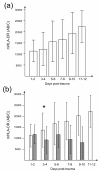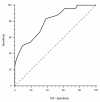Lack of recovery in monocyte human leukocyte antigen-DR expression is independently associated with the development of sepsis after major trauma
- PMID: 21092108
- PMCID: PMC3220028
- DOI: 10.1186/cc9331
Lack of recovery in monocyte human leukocyte antigen-DR expression is independently associated with the development of sepsis after major trauma
Abstract
Introduction: Major trauma is characterized by an overwhelming pro-inflammatory response and an accompanying anti-inflammatory response that lead to a state of immunosuppression, as observed after septic shock. Diminished monocyte Human Leukocyte Antigen DR (mHLA-DR) is a reliable marker of monocyte dysfunction and immunosuppression. The main objective of this study was to determine the relation between mHLA-DR expression in severe trauma patients and the development of sepsis.
Methods: We conducted a prospective observational study over 23 months in a trauma intensive care unit at a university hospital. Patients with an Injury Severity Score (ISS) over 25 and age over 18 were included. mHLA-DR was assessed by flow cytometry protocol according to standardized protocol. Mann-Whitney U-test for continuous non-parametric variables, independent paired t test for continuous parametric variables and chi-square test for categorical data were used.
Results: mHLA-DR was measured three times a week during the first 14 days. One hundred five consecutive severely injured patients were monitored (ISS 38 ± 17, SAPS II 37 ± 16). Thirty-seven patients (35%) developed sepsis over the 14 days post-trauma. At days 1-2, mHLA-DR was diminished in the whole patient population, with no difference with the development of sepsis. At days 3-4, a highly significant difference appeared between septic and non-septic patients. Non- septic patients showed an increase in mHLA-DR levels, whereas septic patients did not (13,723 ± 7,766 versus 9,271 ± 6,029 antibodies per cell, p = .004). Most importantly, multivariate logistic regression analysis, after adjustment for usual clinical confounders (adjusted OR 5.41, 95% CI 1.42-20.52), revealed that a slope of mHLA-DR expression between days1-2 and days 3-4 below 1.2 remained associated with the development of sepsis.
Conclusions: Major trauma induced an immunosuppression, characterized by a decrease in mHLA-DR expression. Importantly, after multivariate regression logistic analysis, persistent decreased expression was assessed to be in relation with the development of sepsis. This is the first study in trauma patients showing a link between the lack of immune recovery and the development of sepsis on the basis of the standardized protocol. Monitoring immune function by mHLA-DR measurement could be useful to identify trauma patients at a high risk of infection.
Figures




References
Publication types
MeSH terms
Substances
LinkOut - more resources
Full Text Sources
Other Literature Sources
Medical

